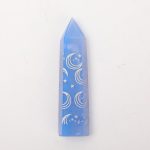The sapphire, a captivating gemstone renowned for its deep blue hue, has captivated hearts and imaginations for centuries. Its allure extends beyond its captivating color to its exceptional properties, making it a prized possession for discerning collectors and gemstone enthusiasts alike.

History and Etymology
The term “sapphire” originates from the Latin word “sapphirus,” which in turn is derived from the Greek word “sappheiros.” Etymologists trace the word’s roots to an ancient Babylonian term meaning “sacred stone.” This reflects the gemstone’s long-held association with divinity and spirituality.
Physical Properties
Sapphire is a variety of the mineral corundum, composed primarily of aluminum oxide. It exhibits a hardness of 9 on the Mohs scale, making it second only to diamond in terms of durability. This exceptional hardness contributes to the gemstone’s resistance to scratching and abrasion.
The characteristic blue color of sapphire is primarily attributed to the presence of trace amounts of iron and titanium. The depth and intensity of the blue can vary depending on the concentration and distribution of these elements. Additionally, exposure to heat treatment can further enhance the gemstone’s color.
Classification and Varieties
Sapphires are classified based on their color and provenance. The most sought-after category is the Kashmir sapphire, renowned for its velvety cornflower blue hue. Other notable varieties include:
- Padparadscha sapphire: A rare and highly prized pinkish-orange variety
- Star sapphire: Exhibited a six-rayed star pattern due to the presence of rutile mineral inclusions
- Yellow sapphire: Believed to bring prosperity and happiness
- Green sapphire: Symbolizes growth, abundance, and nature
Gemstone Quality Factors
When evaluating the quality of a sapphire, several factors are considered:
- Carat weight: Measured in carats (ct), reflecting the gemstone’s size
- Clarity: Refers to the presence or absence of inclusions and blemishes
- Color: Depth, intensity, and hue are crucial in determining a sapphire’s value
- Cut: The design and proportions of the stone influence its brilliance and scintillation
Applications and Symbolism
Sapphires find application in various domains, including:
- Jewelry: Exalted as a birthstone for September, sapphires are popular in engagement rings, pendants, and earrings
- Industrial: Due to its hardness, sapphire is employed in precision instruments, semiconductors, and laser applications
- Medical: Synthetic sapphires are used in surgical procedures as they retain their transparency during high-temperature sterilization
Throughout history, sapphires have held significant symbolism:
- Royalty and Power: Associated with monarchs and nobility
- Wisdom and Knowledge: Believed to enhance mental clarity and perception
- Faith and Spirituality: Revered in many religions as a symbol of heaven and divine favor
Benefits of Sapphire
In addition to its aesthetic appeal, sapphire offers several benefits:
- Durable and Resistant: Exceptionally hard, it is suitable for everyday wear and withstands wear and tear
- Versatile: Available in a wide range of colors, making it suitable for various designs and styles
- Symbolic: Associated with auspicious qualities, such as wisdom, serenity, and prosperity
- Investment Value: High-quality sapphires retain their value and are considered a secure investment option
Table 1: Properties of Sapphire
| Property | Value |
|---|---|
| Chemical composition | Aluminum oxide (Al2O3) |
| Crystal structure | Trigonal |
| Hardness (Mohs scale) | 9 |
| Refractive index | 1.762-1.778 |
| Specific gravity | 3.95-4.1 |
Table 2: Classification of Sapphire
| Variety | Color | Notable Characteristics |
|---|---|---|
| Kashmir sapphire | Cornflower blue | Deep blue, velvety texture |
| Padparadscha sapphire | Pinkish-orange | Rare, highly prized |
| Star sapphire | Six-rayed star pattern | Rutile inclusions |
| Yellow sapphire | Yellow | Symbol of prosperity |
| Green sapphire | Green | Represents growth and nature |
Table 3: Factors Affecting Sapphire Value
| Factor | Importance |
|---|---|
| Carat weight | Directly proportional to value |
| Clarity | Fewer inclusions, higher value |
| Color | Intense, saturated blue most valuable |
| Cut | Well-proportioned, excellent brilliance |
Table 4: Benefits and Uses of Sapphire
| Benefit | Use |
|---|---|
| Durable | Jewelry, engagement rings |
| Versatile | Earrings, pendants, cufflinks |
| Symbolic | Birthstone for September, represents wisdom |
| Investment | Maintains value, considered a stable investment option |
Conclusion
The sapphire stands as an exquisite and enduring gemstone, captivating with its deep blue hue and exceptional properties. From ancient times to modern-day applications, sapphires have adorned royalty, symbolized wisdom and spirituality, and offered immeasurable beauty. As a versatile and durable gemstone, sapphires continue to inspire designers and delight collectors alike. With their timeless appeal and profound symbolism, sapphires remain a true treasure of the mineral world.




























